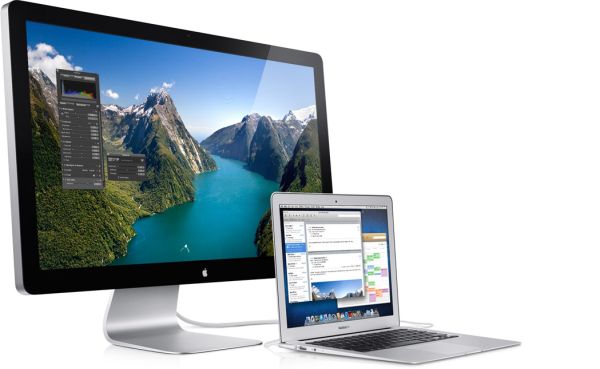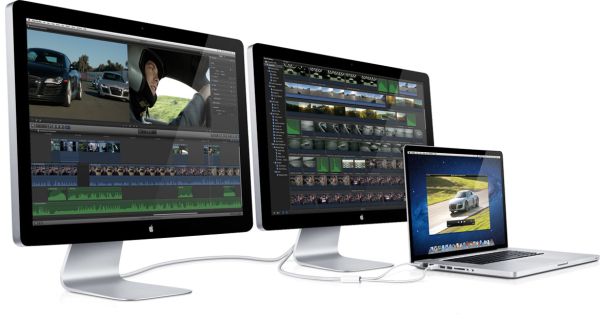Apple Updates Cinema Display, It's a Thunderbolt Display Now
by Kristian Vättö on July 20, 2011 12:25 PM EST- Posted in
- Apple
- Mac
- Cinema Display
- Thunderbolt
- Thunderbolt Display
Along with today’s MacBook Air and Mac mini updates, Apple has also updated their 27” Cinema Display. The display now goes by a new name: the Apple Thunderbolt Display (ATD). As the name implies, the display now features Intel’s new Thunderbolt interface, which Apple has heavily adopted in all new 2011 Macs. The ATD is world’s first commercially available Thunderbolt display and the second Thunderbolt device, the first one being Promise’s Pegasus enclosure.

Lets go through the specifications now:
| Apple Thunderbolt Display Specifications | |
| Screen size | 27" |
| Resolution | 2560x1440 |
| Panel type | In-plane switching (IPS) |
| Brightness | 375 cd/m2 |
| Viewing angles | 178°/178° |
| Contrast ratio | 1000:1 |
| Response time | 12ms |
| Cables (built-in) | Thunderbolt, MagSafe |
| Ports | 3x USB 2.0, FireWire 800, Gigabit Ethernet, Thunderbolt |
| Video and audio | FaceTime HD camera with mic, 2.1 speaker system |
| Dimensions (WxDxH) | 25.7" x 8.15" x 19.35" |
| Weight | 23.5lb |
| Price | $999 |
Essentially, the ATD is just a 27” Cinema Display with Thunderbolt. The screen size is the same, the resolution is the same, and I wouldn’t be surprised if the panel was exactly the same as well. From outside, you can’t see any difference, sans the extra ports. The dimensions are a match. Even the price stays at $999.
The difference comes when we talk about Thunderbolt and what it brings. The Cinema Display had three cables: Mini DisplayPort, MagSafe (power) and USB 2.0. Thanks to Thunderbolt, mDP and USB 2.0 have been merged into one and there are now only two cables: MagSafe and Thunderbolt.
Laptop-as-a-desktop users rejoice, the Thunderbolt Display features FireWire 800, USB 2.0 and Gigabit Ethernet - all of which are carried over the single Thunderbolt cable. There is also a second Thunderbolt port for daisy-chaining. As Thunderbolt provides up to 10Gb/s per channel, it’s more than adequate for 2560x1440 display and an external RAID box as we mentioned in our Promise Pegasus R6 & Mac Thunderbolt Review.
Example of daisy-chaning
Apple's Thunderbolt Display really shows us the potential of Thunderbolt by integrating many different interface standards into a single cable. Honestly the only thing that's missing is audio-out on the Thunderbolt Display itself for users who prefer external speakers.
The biggest, and possibly the only, issue here is USB 2.0 - it feels so outdated considering that nearly all PCs have USB 3.0 now. We probably won't see USB 3.0 support from Apple until Ivy Bridge brings it natively in 2012. However, even with only USB 2.0, the ATD is a great option for the owners of 2011 Macs with Thunderbolt. Apple will continue to sell the existing 27-inch Cinema Display as the new Thunderbolt Display will not work with machines that don't support Thunderbolt.
The Apple Thunderbolt Display is available from Apple's Online Store with an estimated shipping time of 6-8 weeks.











82 Comments
View All Comments
AnnonymousCoward - Sunday, July 24, 2011 - link
AMD has an integrated host."Nobody really wants to see a notebook with 6 ExpressCard slots, an HDMI and a dual-link DVI port..."
Daisy-chaining is already a feature of DisplayPort. So you're looking at 1 USB3 port plus 1 DisplayPort, versus 1 Thunderbolt port.
I agree with peterfares. It's expensive and wasteful, and Intel gets to sell boatloads of its proprietary chips on each end. This isn't like USB, where tons of companies make their own chips.
repoman27 - Tuesday, July 26, 2011 - link
1 USB 3.0 port provides less than 20% of the usable bandwidth of 1 Thunderbolt port and is unsuitable for isochronous applications when more than 1 device is present on the bus. They are not even remotely comparable, end of story. The only reason one would prefer USB 3.0 in lieu of Thunderbolt is if one could not conceive of an actual use for high speed I/O devices and just wanted to prevent Intel from pocketing another $10.AnnonymousCoward - Wednesday, July 27, 2011 - link
There's another huge reason to prefer USB3 over TB: install base. USB is everywhere. TB is _yet another interface standard_, and it's scarce."less than 20%" - outside of raw video, what connectable device can utilize USB3's 3.2Gbps? Nothing. External HDDs top out at 0.7Gbps. No connectable device can even utilize USB3, outside of raw video, and DisplayPort already has that covered.
repoman27 - Wednesday, July 27, 2011 - link
It amuses me how some, such as yourself, crusade so hard to try to prevent anyone from having anything other than the lowest common denominator. Thankfully, there are companies that continue to produce superior technology for those who require or would rather have something better. You don't have to buy it, although I know it breaks your heart to see people with the means buy something that's better than what you have.USB is at revision 3.0 and is already having serious problems trying to advance while still maintaining backwards compatibility. The first release of Thunderbolt runs at 20 Gbps, and it has a clear path forward. With broader availability of DP 1.2 and PCIe 3.0 on the horizon, Thunderbolt will most likely double its bandwidth in a year's time.
"No connectable device can even utilize USB3" - So you'd be happy if they replaced all of the PCIe slots in desktops with USB 3? Any single SandForce SF-2281 SSD can saturate USB 3 (although you'll probably have to plug it in to an external power source since the bus power on USB is woefully inadequate as well). Not to mention 10 Gb Ethernet, digital video sources (DP doesn't go the other way), Fibre Channel, scientific data acquisition devices, etc. And then there's the timing issues on a shared bus. Would you like to see USB 3 used for avionics, drive by wire, or other machine control systems where timing is crucial? Not everyone uses computers solely for checking Facebook and gaming.
FrozenDarkness - Thursday, July 21, 2011 - link
I agree and what people don't realize is that you can't compare the Thunderbotl to the USB 3.0 because USB is already a WELL established platform. When USB 2.0 or 1.1 came out, what was the alternative? there wasn't any.ChristophWeber - Thursday, July 21, 2011 - link
USB 3: Processor interrupts, no RDMA (remote direct memory access), dozens of microseconds latency, i.e huge overhead. In my hands a Sandforce 1200-based SSD tops out at ~145 MB/s over USB 3, while it gives me 265 MB/s directly over SATA.Thunderbolt: None of the above overhead, it's just PCIe in disguise. I.e. put half a dozen SATA ports behind a Thunderbolt connection and they will not be constrained by TB. Demonstrated and proven with the shipping Pegasus RAID units.
You may not think you need TB bandwidth and latency today for your computer, but in a few years we will all look back and wonder how we survived with PCIe being constrained to computer-internals only and made do with multiple, comparatively kludgy ports
(eSATA, anyone - no hot plug in 2011?).
JasonInofuentes - Friday, July 22, 2011 - link
Oddly, the Sony Power Media Dock is an example of the potential for this standard, that USB and Firewire have always lacked. USB offers a limited amount of bandwidth that makes it great for data storage, but not so much for adding features, that's why USB monitors never really took off. Thunderbolt provides a high-speed, high-bandwidth two way interface (the same one powering your internal peripherals) and makes it ideal for things like external video cards. This solves the problem of limited upgradeability of devices like the MBP or MBA. What does the standard need to be a success? Peripherals that look beyond the paradigm set-forth by USB.Will it work? I don't know, but I know I'm interested. Thanks for the comments, keep'em coming.
zxnczxcn - Sunday, July 24, 2011 - link
Quote "...as the new Thunderbolt Display will not work with machines that don't support Thunderbolt."Please input this URL:
http://www---- bestniceshoes ----com
http://www---- bestniceshoes ----com
Best quality, Best reputation , Best services !!!
smokedturkey - Wednesday, July 20, 2011 - link
I think HTC should sue apple over the Thunderbolt name!!!!Souka - Wednesday, July 20, 2011 - link
Other way around...Apple will sue HTC and win.case in point:
Ever hear of the iPhone?
Cisco invented and built it first....didn't matter, lawsuits happened, apple won.